Chemical Reviews上两篇关于离子液体的综述 Room-Temperature Ionic Liquids Solvents for Synthesis an
- 格式:pdf
- 大小:162.06 KB
- 文档页数:14
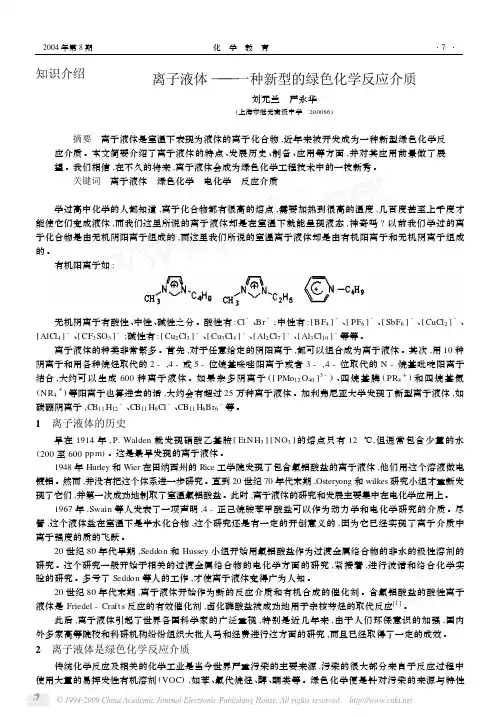
知识介绍离子液体———一种新型的绿色化学反应介质刘元兰 严永华(上海市继光高级中学 200086) 摘要 离子液体是室温下表现为液体的离子化合物,近年来被开发成为一种新型绿色化学反应介质。
本文简要介绍了离子液体的特点、发展历史、制备、应用等方面,并对其应用前景做了展望。
我们相信,在不久的将来,离子液体会成为绿色化学工程技术中的一枝新秀。
关键词 离子液体 绿色化学 电化学 反应介质 学过高中化学的人都知道,离子化合物都有很高的熔点,需要加热到很高的温度,几百度甚至上千度才能使它们变成液体,而我们这里所说的离子液体却是在室温下就能呈现液态,神奇吗?以前我们学过的离子化合物是由无机阴阳离子组成的,而这里我们所说的室温离子液体却是由有机阳离子和无机阴离子组成的。
有机阳离子如:无机阴离子有酸性、中性、碱性之分。
酸性有:Cl -、Br -;中性有:[BF 4]-、[PF 6]-、[SbF 6]-、[CuCl 2]-、[AlCl 4]-、[CF 3SO 3]-;碱性有:[Cu 2Cl 3]-、[Cu 3Cl 4]-、[Al 2Cl 7]-、[Al 3Cl 10]-等等。
离子液体的种类非常繁多。
首先,对于任意给定的阴阳离子,都可以组合成为离子液体。
其次,用10种阴离子和用各种烷烃取代的2-,4-或5-位烷基咪唑阳离子或者3-,4-位取代的N -烷基吡啶阳离子结合,大约可以生成600种离子液体。
如果杂多阴离子([PMo 12O 40]3-)、四烷基膦(PR 4+)和四烷基氮(NR 4+)等阳离子也算进去的话,大约会有超过25万种离子液体。
加利弗尼亚大学发现了新型离子液体,如碳硼阴离子,CB 11H 12-、CB 11H 6Cl -、CB 11H 6Br 6-等。
1 离子液体的历史 早在1914年,P.Walden 就发现硝酸乙基胺[EtN H 3][NO 3]的熔点只有12℃,但通常包含少量的水(200至600ppm )。

离子液体中的酶促反应综述-有机化学论文-化学论文——文章均为WORD文档,下载后可直接编辑使用亦可打印——离子液体(Ionic liquids,ILs)具有几乎为零的蒸汽压、高的热稳定性、化学稳定性、宽的液态温度范围、较强的溶解性与催化活性等优异理化特性,因而被称为21世纪的绿色溶剂,现已被广泛应用于分离与萃取[1,2]、电化学[3,4]、纳米技术[5,6]、生物技术[7]以及工程技术[8,9]等各个领域中。
酶是活细胞产生的一类具有催化功能的生物大分子,酶催化的反应称为酶促反应。
大量的研究表明:酶促反应具有高效、高选择性和反应条件温和等特性[10],作为一种绿色合成方法是现代合成方法学的重要发展方向之一。
酶促反应的介质最初采用的是水,但在水中酶分子的空间结构容易改变而失去催化活力[11],另外许多有机反应难以在水相中进行;直至非水介质中酶促反应研究的出现,极大推动了酶在合成化学中的应用[12,13]。
结合酶和ILs的优点,所以ILs中的酶促反应引起了研究者的关注。
现在ILs中的酶催化反应主要包括有机合成反应[14]和聚合反应[15]两大类,由于酶和ILs两者都具备对环境友好的优点,所以在ILs中的酶促反应是极具研究意义的课题之一。
本文对近年来在ILs中的酶促反应进行了综述。
1 离子液体中酶促有机合成反应脂肪酶(Lipases)是由活细胞产生的具有催化功能的蛋白质分子,它通常具有催化活性,因此酶通常被作为催化剂。
近年来酶催化反应的研究越来越受到关注,其中酶应用于小分子催化反应主要包括:酯交换反应、水解反应和氧化还原反应等[16]。
Lazano P等[17]以脂肪酶催化丁酸乙烯酯与正丁醇的酯交换反应合成丁酸丁酯,反应介质采用4种ILs([C2MIm]-BF4、[C2MIm]NTf2、[C4MIm]PF6和[C4MIm]NTf2)以及2种有机溶剂(正丁烷、己烷),研究结果表明脂肪酶在ILs中的催化活性远高于其在有机溶剂中的活性,并且酶的活性随着ILs极性的增强而增大,在连续操作过程中脂肪酶也仍然保持着较高的活性。
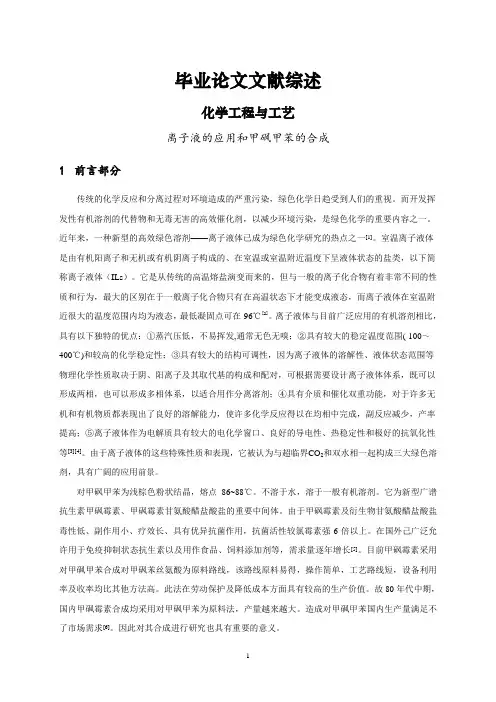
毕业论文文献综述化学工程与工艺离子液的应用和甲砜甲苯的合成1前言部分传统的化学反应和分离过程对环境造成的严重污染,绿色化学日趋受到人们的重视。
而开发挥发性有机溶剂的代替物和无毒无害的高效催化剂,以减少环境污染,是绿色化学的重要内容之一。
近年来,一种新型的高效绿色溶剂——离子液体已成为绿色化学研究的热点之一[1]。
室温离子液体是由有机阳离子和无机或有机阴离子构成的、在室温或室温附近温度下呈液体状态的盐类,以下简称离子液体(ILs)。
它是从传统的高温熔盐演变而来的,但与一般的离子化合物有着非常不同的性质和行为,最大的区别在于一般离子化合物只有在高温状态下才能变成液态,而离子液体在室温附近很大的温度范围内均为液态,最低凝固点可在-96℃[2]。
离子液体与目前广泛应用的有机溶剂相比,具有以下独特的优点:①蒸汽压低,不易挥发,通常无色无嗅;②具有较大的稳定温度范围(-100~400℃)和较高的化学稳定性;③具有较大的结构可调性,因为离子液体的溶解性、液体状态范围等物理化学性质取决于阴、阳离子及其取代基的构成和配对,可根据需要设计离子液体体系,既可以形成两相,也可以形成多相体系,以适合用作分离溶剂;④具有介质和催化双重功能,对于许多无机和有机物质都表现出了良好的溶解能力,使许多化学反应得以在均相中完成,副反应减少,产率提高;⑤离子液体作为电解质具有较大的电化学窗口、良好的导电性、热稳定性和极好的抗氧化性等[3][4]。
由于离子液体的这些特殊性质和表现,它被认为与超临界CO2和双水相一起构成三大绿色溶剂,具有广阔的应用前景。
对甲砜甲苯为浅棕色粉状结晶,熔点86~88℃。
不溶于水,溶于一般有机溶剂。
它为新型广谱抗生素甲砜霉素、甲砜霉素甘氨酸醋盐酸盐的重要中间体。
由于甲砜霉素及衍生物甘氨酸醋盐酸盐毒性低、副作用小、疗效长、具有优异抗菌作用,抗菌活性较氯霉素强6倍以上。
在国外己广泛允许用于免疫抑制状态抗生素以及用作食品、饲料添加剂等,需求量逐年增长[5]。


2017年04月离子液体在有机合成中应用研究综述柴朴(绍兴文理学院,浙江绍兴312000)摘要:现今人们越来越关注有机合成反应的环保问题,对于反应的溶剂人们进行了深入研究,其中离子液体因稳定性好、污染小等优点受到了人们的青睐。
本文就离子液体的特性、分类、在有机合成反应中的应用进行了简要分析,相信离子液体一定会有广阔的应用前景。
关键词:离子液体;有机合成;应用随着化学工艺的发展,人们越来越重视环保问题。
目前人们在有机合成过程中使用的有机溶剂毒性较大,污染十分严重。
对此,科研人员将研究重点转移至开发绿色溶剂方面,其中,离子液体就是一种性能较为优异的绿色溶剂,可以应用到有机合成反应中。
离子液体是由有机阳离子和无机或有机阴离子构成的、在室温或室温附近温度下成液体状态的盐类[1]。
离子液体作为反应溶剂因其催化活性高、不易挥发、不易燃、溶解性好、易于分离等优点受到人们的广泛关注,本文就离子液体特性、分离及在有机合成中的应用进行了简要概述。
1离子液体特性与现有的有机溶剂相比,离子液体有许多优良特性,使其可以作为性能优良的绿色溶剂进行应用,具体如下[2]:(1)维持液态的温度范围大:300℃及以上,反应热稳定性较好;(2)蒸汽压较低,所以不容易挥发,产生的污染较小;(3)溶解性能优良,对很多有机或无机物质的溶解性都很大,这是传统有机溶剂所欠缺的;(4)导电性能优良,电化学窗口很宽,在电化学中有较高的应用价值;(5)极性较大,可调性较高,可以作为多相体系进行应用。
2离子液体分类离子液体的种类多种多样,分类方式也各不相同,例如:改变阴阳离子组合方式可以得到不同的离子液体,以适应不同合成工艺需要。
现今最常用的分类方法是按照有机阳离子母体的不同而进行分类的,该分类方法将离子液体分为四类:(1)季按盐类;(2)季磷盐类;(3)吡啶盐类;(4)咪唑盐类[1]。
3离子液体在有机合成中应用3.1在Diels-Alder 反应中应用离子液体作为溶剂对于Diels-Alder 反应有着很好的促进作用。
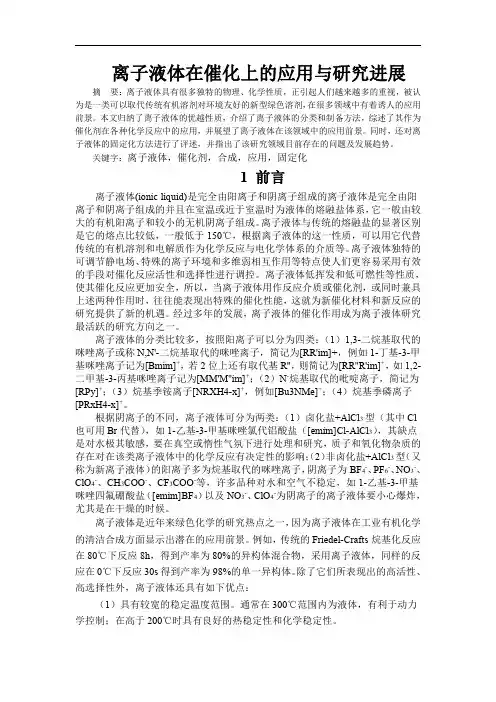
离子液体在催化上的应用与研究进展摘要:离子液体具有很多独特的物理、化学性质,正引起人们越来越多的重视,被认为是一类可以取代传统有机溶剂对环境友好的新型绿色溶剂,在很多领域中有着诱人的应用前景。
本文归纳了离子液体的优越性质,介绍了离子液体的分类和制备方法,综述了其作为催化剂在各种化学反应中的应用,并展望了离子液体在该领域中的应用前景。
同时,还对离子液体的固定化方法进行了评述,并指出了该研究领域目前存在的问题及发展趋势。
关键字:离子液体,催化剂,合成,应用,固定化1前言离子液体(ionic liquid)是完全由阳离子和阴离子组成的离子液体是完全由阳离子和阴离子组成的并且在室温或近于室温时为液体的熔融盐体系,它一般由较大的有机阳离子和较小的无机阴离子组成。
离子液体与传统的熔融盐的显著区别是它的熔点比较低,一般低于150℃,根据离子液体的这一性质,可以用它代替传统的有机溶剂和电解质作为化学反应与电化学体系的介质等。
离子液体独特的可调节静电场、特殊的离子环境和多维弱相互作用等特点使人们更容易采用有效的手段对催化反应活性和选择性进行调控。
离子液体低挥发和低可燃性等性质,使其催化反应更加安全,所以,当离子液体用作反应介质或催化剂,或同时兼具上述两种作用时,往往能表现出特殊的催化性能,这就为新催化材料和新反应的研究提供了新的机遇。
经过多年的发展,离子液体的催化作用成为离子液体研究最活跃的研究方向之一。
离子液体的分类比较多,按照阳离子可以分为四类:(1)1,3-二烷基取代的咪唑离子或称N,N'-二烷基取代的咪唑离子,简记为[RR'im]+,例如1-丁基-3-甲基咪唑离子记为[Bmim]+,若2位上还有取代基R'',则简记为[RR''R'im]+,如1,2-二甲基-3-丙基咪唑离子记为[MM'M''im]+;(2)N-烷基取代的吡啶离子,简记为[RPy]+;(3)烷基季铵离子[NRXH4-x]+,例如[Bu3NMe]+;(4)烷基季磷离子[PRxH4-x]+。

室温离子液体在无机纳米材料制备中的应用摘要:室温离子液体的物理和化学性质相对稳定,具有结构可调的特性。
作为一种新功能材料广泛用于纳米材料的制备领城。
本文就近几年国内外相关研究进展,对室温离子液体在无机纳米材料制备中的应用进行综述。
关键词:离子液体;无机材料;纳米材料一、引言随着人们环境保护意识的不断提高,从上世纪90年代起,绿色化学日益成为化学科学发展的前沿分支,它要求从根本上消除化学化工过程对环境的污染。
其中,室温离子液体(room temperature ionic liquids, RTILs)作为一种新兴绿色溶剂,在化学和工业等许多领域受到了广泛关注[1,2]。
室温离子液体,是指室温或接近室温时呈液态的离子化合物,一般由体积相对较大的有机阳离子(如烷基咪唑盐、烷基吡啶盐、烷基季铵盐、烷基季盐、杂环芳香化合物及天然产物的衍生物等)和相对较小的无机或有机阴离子( 如[ PF6 ]-、[BF4 ]- 、[SbF6 ]- 、NO3- 、[AlCl4 ] -、[CF3SO3 ]- 、[CH3CO2 ]-、[CF3CO2 ]- 等)构成。
它的熔点很低, 可以到-96℃:具有很宽的液态温度范围,甚至超过400℃仍然保持液态。
其蒸气压几乎可以忽略,不挥发,污染少,对环境友好,回收方便,在替代传统的有机溶剂方面潜力巨大。
它的电化学窗口宽(>5V),导电性、导热性和热力学稳定性好,并且具有高的热容和热能储存密度。
其酸度、极性及双亲性可控,能与不同的化合物混溶。
这些独特的物理化学性质及功能使RTILs成为一类备受关注的新型介质和材料。
早在1914年,Sudgen等就报道了有机盐硝酸乙基铵(EAN)在室温下为液态。
1948年,乙基吡啶溴化物-三氯化铝(C-PyBr2-AlCl3 ) 标志着AlCl3 型离子液体的诞生。
1982年,随着1-乙基-3-甲基咪唑氯化物-三氯化铝([Emim]Cl-AlCl3 )的发现,对RTILs的研究逐渐增多起来,包括电化学、催化、有机合成和化学分离萃取等。

Catalysis in Ionic LiquidsVasile I.Paˆrvulescu*,†and Christopher Hardacre*,‡Department of Chemical Technology and Catalysis,University of Bucharest,B-dul Regina Elisabeta4-12,Bucharest030016,Romania and The QUILL Centre/School of Chemistry and Chemical Engineering,Queen’s University Belfast,Belfast BT95AG,Northern Ireland,United KingdomReceived August9,2006Contents1.Introduction26162.Nanostabilized Catalysts in ILs26172.1.ILs as Solvents for Synthesis ofNanoparticles26172.2.Active Complexes of Metal Compounds withILs26192.3.Supported IL-Stabilized Catalysts26192.4.ILs as Templates for HeterogeneousCatalysts26212.5.Stabilization of IL Emulsions by Nanoparticles26233.Hydrogenations in ILs26233.1.Hydrogenation on IL-Stabilized Nanoparticles26233.1.1.Hydrogenation of1,3-Butadiene26233.1.2.Hydrogenation of Alkenes and Arenes26243.1.3.Hydrogenation of Ketones26243.2.Homogeneous Catalytic Hydrogenation in ILs26243.3.Hydrogenation of Functionalized ILs26253.3.1.Selective Hydrogenation of Polymers26253.4.Asymmetric Hydrogenations26263.4.1.Enantioselective Hydrogenation26263.5.Role of the ILs Purity in HydrogenationReactions26283.6.Hydrogenation via Heterogeneous Catalysisin ILs26283.7.Biocatalysis in ILs for Reduction of OrganicMolecules26303.8.Hydrogen-Transfer Reactions in ILs26304.Catalytic Oxidation in ILs26314.1.ILs as a Media for Organic Oxidations26314.2.Homogeneous Catalytic Oxidation in ILs26324.2.1.Glaser Oxidative Coupling26324.2.2.Epoxidation26324.2.3.Hydrocarbons to Other OxygenatedCompounds26324.2.4.Alcohols to Carbonyl and Carbonyl toCarboxylate Compounds26334.2.5.Oxidation of C d NOH Bonds26344.2.6.Oxidation of Thiols26344.2.7.Oxybromination26354.3.Homogeneous Asymmetric CatalyticOxidation in ILs26354.4.ILs in Kinetic Resolution Reactions26354.5.Heterogeneous Catalytic Oxidation in ILs26354.6.Electrochemical Oxidation in ILs26364.7.Biooxidation in ILs26375.Acid−Base-Catalyzed Reactions in ILs2638 5.1.Acid-Catalyzed C−C and C−X Bond-FormingReactions26385.1.1.Sakurai Reaction26395.1.2.Henry Reaction26395.1.3.Carbonyl Allylation of Aldehydes andKetones26395.1.4.Stille Coupling2639 5.2.Sulfonylation Reactions of Aromatics2639 5.3.Silylstannations of R, -Unsaturated CarbonylCompounds2640 5.4.Debromination of2-Bromoketones2640 5.5.Protection of Carbonyls to Acetals and Ketals2640 5.6.Deprotection2640 5.7.Ligand Substitution Reactions:FluorinationReactions2640 5.8.Isomerization2641 5.9.Acid-Catalyzed Reactions in ILs UsingHeterogeneous Catalysts2641 5.10.Deoximation2641 5.11.Acid-Catalyzed Reactions with Task-SpecificILs2642 5.12.Base-Catalyzed Reactions26425.13.Enzymatic Catalyzed Aldol Reactions in ILs26436.Carbonylation and Hydroformylation2643 6.1.Carbonylation26436.1.1.Carbonylation of Aromatic Hydrocarbonsvia Homogeneous Catalysis26436.1.2.Carbonylation of Aryl Halides andTerminal Alkynes via HomogeneousCatalysis26436.1.3.Pauson−Khand Reaction26446.1.4.Carbonylation of Alcohols viaHomogeneous Catalysis26446.1.5.Carbonylation of Amines andNitrobenzene via Homogeneous Catalysis2644 6.2.Carbonylation via Heterogeneous Catalysis26456.2.1.Carbonylation of Amines andNitrobenzene2645 6.3.Hydroformylation26456.4.Hydroformylation via Heterogeneous Catalysis26467.Dimerization26467.1.Diels−Alder Reactions26488.Polymerization2648 8.1.Radical Polymerization in ILs2649 8.2.Charge-Transfer Polymerization2649*To whom correspondence should be addressed.E-mail:v_parvulescu@ chem.unibuc.ro(V.I.P.)and c.hardacre@(C.H.).†University of Bucharest.‡Queen’s University Belfast.2615Chem.Rev.2007,107,2615−266510.1021/cr050948h CCC:$65.00©2007American Chemical SocietyPublished on Web05/23/20078.3.Radical Polymerization Using Chiral ILsand/or Chiral Ligands26508.4.Biphasic Radical Polymerization 26508.5.Ionic Polymerization 26508.6.Oxidative Polymerization 26509.Heck Reaction26509.1.Homogeneous Catalysis 26509.2.Heterogeneous Catalysis 265210.Suzuki Cross-Coupling265310.1.Heterogeneous Catalysis 265311.Other Reactions 265311.1.Hydroarylation 265311.2.Hydroesterification265311.3.Ring-Closing Metathesis of Di-,Tri-,andTetrasubstituted Dienes 265411.4.Trost −Tsuji C −C Coupling265411.5.Thioacetalization of Carbonyl Compounds 265411.6.Gewald Synthesis265511.7.Reactions of Carbonyl Compounds 265511.7.1.Reactions with Indoles 265511.7.2.Michael Additions265511.7.3.Baylis −Hillman Reaction 265711.7.4.Stetter Reaction265711.7.5.Cross-Coupling between Aldehydes andAllylic Alcohols265711.7.6.Cross-Condensation of CarbonylCompounds with Derivatives of Cyanoacetic Acid265711.7.7.Mannich-type Reaction 265711.7.8.Mukaiyama Aldol Reaction265811.7.9.Reductive Amination of CarbonylCompounds with Amines265811.7.10.1,4-Conjugate Addition of UnmodifiedAldehyde265811.7.11.Carbonyl −Ene Reaction265811.7.12.Tandem Cyclization −1,3-DipolarCycloaddition Reaction of R -Diazo Ketones265811.7.13.CO 2Cycloaddition to Epoxide 265911.7.14.R -Tosyloxylation of Ketones 265911.8.Heterogeneous Catalysis 265911.8.1.Hydroamination Reactions 265912.Conclusions 265913.Acknowledgment 266014.References26601.IntroductionCatalytic reactions in ionic liquids (ILs)have been examined for at least 20years;for example,the first report of the use of an IL as a catalyst in Friedel -Crafts acylation was reported in 1986.1However,it is only in the past decade that there has been an explosion in their use in a wide range of catalytic and stoichiometric reactions as well as in many other applications,and this has led to a greater than exponential growth in the number of papers published.A number of good reviews cover the area of ILs in general,for example.2-9Although they are often considered as green alternatives to volatile organic solvents,notably chlorinated hydrocarbons,their toxicity and biodegradability properties 10have not been fully determined and the manufacture of the ILs often contains a metathesis step which limits their green credentials to some extent.However,in both of these areassignificant steps have been made in the understanding and creation of cleaner routes to the preparation of ILs.11,12In addition,analytical methods for determination of the well-characterized materials have been developed.13-19This is particularly important in catalysis where the impurity in the solvent can have a significant impact on the selectivity and activity.Furthermore,determination of the sensitivity of the system to impurities can significantly affect the economics of any process.Besides their advantages with respect to environmental impact,a number of critical aspects of ILs make them an interesting medium in which to study chemical syntheses.The large number of cations and anions allow a wide range of physical and chemical characteristics to be achieved,including volatile 20and involatile systems,and thus the terms “designer”and “task-specific”ILs have been developed.21,22This allows not only control over processing of the reaction but also control over solvent -solute interactions.The latter is important,and the fact that these solvents are ionic andVasile I.Parvulescu received his Master’s degree in Catalysis from the Polytechnic University of Bucharest in 1979and in 1986obtained his Ph.D.degree in Chemistry from the same university,where he investigated the selectivity of bi-and multimetallic catalysts in hydrogenation of aromatic hydrocarbons.After several years as high-signor researcher at the Institute of Inorganic and Rare Metals,in 1992he joined the University of Bucharest,where he became a full professor in 1999.His current interests concern the study of heterogeneous catalysts for green and fine chemistry and environmental protection.Chris Hardacre studied Natural Sciences at the University of Cambridge,where he also obtained his Ph.D.degree in 1994.After SERC and Emmanuel College research fellowships he was appointed to a Lectureship in Physical Chemistry at the Queen’s University of Belfast in 1995.In 2003,he became a professor of Physical Chemistry.His current interests include the understanding of gas-and liquid-phase catalytic processes for emission control,clean energy production,and fine chemical synthesis as well as the study and use of ionic liquids.2616Chemical Reviews,2007,Vol.107,No.6Pa ˆrvulescu and Hardacrehighly structured,for example,23-28can give rise to a distinct chemistry of their own compared with molecular solvent systems in both achiral and chiral processes.In any process the steps following reaction are often at least as important for the overall environmental impact and economics.In this respect,ILs have been shown to have a significant advantage over conventional solvents for homo-geneously catalyzed reactions.In these cases,the IL may be used in“biphasic catalysis”8or the catalyst can be entrapped or‘‘immobilized”,allowing extraction/distillation of the organic product and the IL/catalyst system reused. Recycling of the IL/catalysts in this way has been demon-strated in many examples and is vital given the high capitalcost of the solvent.Similar considerations also exist forheterogeneous catalysts and biocatalysts.In particular,processes involving nanoparticulate catalysts and ILs havebeen particularly effective in screening the charged layer onthe surface of the colloids,preventing aggregation andstabilizing the system.29By tuning the ILs’composition,thestability,size,and solubility of the nanoparticles may all betuned.30The same properties that make ILs effective solvents alsomake them interesting liquids for studies involving sonochem-istry,acoustic cavitation,and sonoluminescence.Recentadvances in using ultrasound to accelerate chemical reactionsconducted in ILs have found them,in combination withcatalysis,to be a versatile solution in several applications.31 The aim of this paper is to provide a state of the art reviewin the use of ILs’solvents in catalyzed reactions.Given thelarge amount of studies on homogeneously versus hetero-geneously catalyzed process as reported in ILs,the formerpapers will be used as illustrative examples only for the widerange of reactions studied.Furthermore,where appropriate,the use of ILs in biocatalytic and electrocatalyzed reactionshas also been reviewed.Within this review1-alkyl-3-methyl imidazolium cationsare denoted as[C n mim]+,1-alkyl-2,3-dimethyl imidazoliumcations are denoted as[C n dmim]+,1-alkyl-3-alkyl′imid-azolium cations are denoted as[C n C n′mim]+,N-alkylpyri-dinium cations are denoted as[C n pyr]+,4-methyl-N-alkylpyridinium cations are denoted as[C n mpyr]+,N-alkyl,N-methyl pyrrolidinium cations are denoted as[C n mpyrr]+,tetraalkylphosphonium cations are denoted as[P nn′n′′n′′′]+,andtetraalkylammonium cations are denoted as[N nn′n′′n′′′]+wheren represents the alkyl chain length attached to the N or Pcenter.The anion bis(trifluoromethylsulfonyl)imide,i.e.,[(CF3SO2)2N]-,is denoted as[NTf2]-,and triflate is denotedas[OTf]-.2.Nanostabilized Catalysts in ILs2.1.ILs as Solvents for Synthesis of NanoparticlesNanoparticle catalysts have attracted large interest becausethey exhibit a high surface to bulk metal ratio,which allowsmore efficient use in practice.This aspect is frequentlyaccompanied by large enhancements in the activity andselectivity where they are used as catalysts.32The recentachievements in this field allow control over the composition(including nanoalloys materials)and size.33-35In spite ofthese advantages,nanocatalysts are kinetically unstable withrespect to agglomeration to the bulk metal and thereforerequire stabilization.Therefore,to be used they needstabilization by either surface-ligating anions or other ligands (Scheme1).In this way it is possible to realize additional control,mostly on the solubility in an appropriate solvent and their isolation.36Combining different stabilizing effects may even improve the performance of nanoparticle catalysts. For example,Finke and co-workers37,38showed that co-stabilization of rhodium nanoparticles with polyoxoanions and tetrabutylammonium cations leads to a high improvement of turnover frequency(TOF)for hydrogenation of olefins and arenes.An important advantage of using ILs in such preparations is that they facilitate inorganic synthesis from highly polar starting materials under ambient conditions and under anhydrous or water-poor conditions.In this way,hydroxide or oxy-hydrate formation can be suppressed.Several nanometallic catalysts have been shown to be activated after stabilization with ILs.Dupont et al.39,40 reported that iridium nanoparticles stabilized by the IL [C4mim][PF6]showed a large increase in activity for the biphasic hydrogenation of various olefins and arenes under mild reaction conditions.These nanoparticles were obtained via rapid reduction of a[IrCl(cod)]2(cod)1,5-cycloocta-diene)complex in[C4mim][PF6]with hydrogen at75°C. Structural characterization confirmed the colloidal properties of the particles(2-2.5nm)and XRD the existence of iridium as Ir(0).Although the presence of water in the system causes decomposition of[C4mim][PF6],no influence on the catalytic performance of the ionic media was observed.39Recently, this system has been examined by detailed kinetic modeling which indicated that the nanoparticles acted as a heteroge-neous catalyst via a simple Langmuir adsorption mecha-nism.41The IL is thought to limit diffusion of the nanopar-ticles and thus promote formation of small particles and limit their growth.A very similar procedure has also been applied to prepare rhodium40and ruthenium nanoparticles.42Pal-ladium43and platinum44nanoparticles with sizes of about 4.9and2.5nm,respectively,were also obtained following the same protocol but using different precursors,i.e., Pd(acac)2or Pt2(dba)3dissolved in[C4mim][PF6]or[C4mim]-[BF4].Stabilization of gold(and platinum)nanoparticles by imidazolium derivatives has also been reported.45-47Gold nanoparticles of∼5nm were obtained by reduction of an aqueous solution of HAuCl4with an excess amount of NaBH4in the presence of3.3′-[disulfanylbis(hexane-1,6-diyl)]-bis(1-methyl-1H-imidazol-3-ium)dichloride.Formation of[BF4]--or[PF6]--based structures was simply achieved via an ionic exchange process.Significantly,gold nano-particles of about 3.6nm stabilized by a zwitterionic imidazolium sulfonate-terminated thiol(Figure1)exhibit a remarkably high stability in aqueous solutions with high concentrations of electrolytes,ILs,and proteins.Scheme1.Schematic Representation of Electrostatic Stabilization of Metal ColloidParticlesCatalysis in Ionic Liquids Chemical Reviews,2007,Vol.107,No.62617Larger gold particles (48-49nm)were also prepared by reduction of HAuCl 4but using citrate as a reductant in [C 4mim][PF 6].48However,to avoid precipitation of these larger particles,the presence of tetradecyltrimethylammo-nium bromide,as a cationic surfactant,was required.In order to avoid boric acid impurities in the resultant nanoparticles,clean reduction of HAuCl 4with CO in [C 4mim][BF 4]was investigated.49Water was found to be an important parameter in controlling the particle size which was found to increase as the concentration of water was raised.Furthermore,using n -hexane as a phase-transfer solution,the morphology of the gold nanoparticles into a ring structure could be achieved.The capability of ILs to stabilize noble metal was also demonstrated for the extraction of gold and silver from ores.50Using [C 4mim][HSO 4]as a solvent it was demonstrated that solubilized thiourea selectively complexed these elements,leading to stable structures.Although imidazolium-based ILs have been widely dem-onstrated as a good stabilizing agent for nanoparticles,in some cases it is found that agglomeration still leads to a loss of activity,indicating that IL stabilization alone does have limitations.Adding other materials to ILs can combine different types of stabilizing effects,leading to more stable nanoparticles.It is important to note,however,that com-monly used organic stabilizers,for example,1,10-phenan-throline and poly(N -vinyl-2-pyrrolidone),generally have low solubility in ILs.In contrast,synthesis of ionic copolymers containing imidazolium IL-like units,which can act as soluble bifunctional costabilizers when dissolved in ILs,enhance the stability of the nanocatalysts.1-Vinyl-3-alkyl imidazolium salts have been prepared from the N-alkylation of 1-vinylimidazole with the corresponding alkyl halides.The polymers were then synthesized by free-radical copolymer-ization of the 1-vinyl-3-alkyl imidazolium halide and N-vinyl-2-pyrrolidone using azo-bis-isobutyronitrile as the initiator in methanol.The resulting copolymers were highly soluble in 1-butyl-3-methylimidazolium ILs as well as in other highly polar organic solvents such as methanol.Rhodium nanopar-ticles were reported to be prepared and stabilized by hydrogen reduction of RhCl 3‚3H 2O in the presence of the copolymers dissolved in [C 4mim][BF 4]IL,resulting in a relatively narrow unimodal size distribution with a diameter of 2.9(0.6nm is observed.51Another approach for the ILs’stabilization of reduced nanoparticles was proposed by Mevellec et al.52Rhodium nanoparticles (∼2.4nm)were formed in an aqueous solution of N ,N -dimethyl-N-dodecyl-N-(2-hydroxyethyl)ammonium ing a metathesis step,the corresponding [NTf 2]--based IL was formed,which separated and removed the nanoparticles from the water phase.The IL acted as a stabilizer and had to be diluted with [C 4mim][PF 6]to enable the particles to be used as a catalyst.Nanoparticles can also be formed during reactions using a homogeneous catalyst as the precursor.The first nanopar-ticles to be reported in ILs fall into this category,where in the Heck reaction Pd(OAc)2was thermally decomposed inthe IL and shown to form highly stable 1-2nm Pd clusters by EXAFS and TEM.53,54Also,Heck or Suzuki and Stille coupling reactions carried out using Pd(OAc)2treated with tetrabutylammonium acetate in tetrabutylammonium bromide led to fast formation of Pd nanoparticles of 2-6nm in size,which were very active in these reactions.55-57In the palladium nanoparticle-catalyzed Heck reaction in ILs,detailed TEM studies have shown that the role of the cluster may be to act as a reservoir.58The larger particles are thought to break up on oxidative addition of the phenyl iodide and,after the reaction,can either continue in the catalytic cycle or reagglomerate.The palladium particles,reported therein,before reaction were ∼2nm,which is consistent with other TEM and EXAFS studies,but after reaction they were 6nm.Other reactions,like the Sonogashira coupling,were reported to be catalyzed by Pd(0)nanoparticles of 10-14nm using [C 4C 4im][BF 4]as the solvent and ultrasound irradiation.59Although the IL is an efficient stabilizer in many cases,additional stabilization has been shown using PEG as a modifier.60Carbapalladacycle complexes also decompose in PEG upon reaction;the resulting Pd nanoparticles (2-5nm)are stabilized by PEG acting as ligand.In this way,a reusable,homogeneous system in PEG has been developed that is able to catalyze the Suzuki and Sonogashira couplings.PVP-protected Pd nanoparticles have also been used for methoxycarbonylation of iodobenzene.61Therein,imidazo-lium-based ILs inhibited reaction via formation of a carbene complex,whereas good activity was found in tetraalkyl-ammonium-and N-alkylpyridinium-based ILs.Thiol-func-tionalized ILs have been utilized to promote formation of palladium nanowires.Uniform nanowires of 2-4nm were formed,which were found to be active and recyclable for the Sonogashira coupling between phenylacetylene and phenyliodide in isopropyl alcohol.62Most reports using the combination of ILs with nanopar-ticles have concentrated on their morphology and catalytic activity.However,the mechanism by which the particles form and the IL stabilization effect have been much less examined.In conventional media,the stability of the colloids is explained according to the DLVO (Derjaguin,Landau,Verwey,Overbeek)theory.63-65Equally charged particle surfaces lead to Coulombic repulsion,i.e.,the interaction potential decreases with particle surface distance.Following the DLVO theory the superposition with the permanently present van der Waals attraction can lead to a net interaction potential,which exhibits a local maximum.However,this theory can only explain the stabilization but not the additional activation of such ing Ir(0)nanoparticles as a model,prepared via reduction of [(1,5-COD)Ir(CH 3CN)2]BF 4under H 2in the presence of a proton sponge in acetone and predetermined but variable amounts of [C 4mim][NTf 2],Starkey et al.66investigated formation of nanoparticles in a range of ILs using deuterium labeling and 2H NMR,indicating that formation of N-heterocyclic carbenes from imidazolium-based ILs and subsequent ligation of the nano-particles is important.This is consistent with other studies which have shown formation of the active catalytic carbene species in ILs.54,67The carbene is thought to form via C -H oxidative addition at the acidic C(2)hydrogen on the imidazolium cation and clearly shows that the IL cannot be considered as an innocent solvent.Further evidence for the capability of ILs to form multiple hydrogen bonds has been reported by Mele et al.68Coupled with the results of Starkey et al.66a mechanism involving molecular recognitionandFigure 1.Schematic representation of the stabilization interactionbetween the zwitterionic imidazolium sulfonate-terminated thiol with a gold cluster.Reproduced by permission of The Royal Society of Chemistry.472618Chemical Reviews,2007,Vol.107,No.6Pa ˆrvulescu and Hardacreself-organization processes,i.e.,close to that found in supramolecular chemistry,is likely.Antonietti et al.considered that stabilization of the nanoparticles was due to the IL acting as a pure “universal”ligand.69The low interfacial tension of the solvent favors high nucleation rates and leads to small particles which undergo Ostwald ripening only weakly.The IL structure is important in this regard as it can easily incorporate many species due to the presence of hydrophobic regions and a high directional polarizability,which is oriented parallel or perpendicular to the dissolved species.Alloying noble metals with group VIII elements is known to enhance the catalytic behavior and selectivity of the noble metals in various reactions.70However,this is conventionally achieved using high temperatures and not readily applicable to solution-phase chemistry due to the volatile nature of the solvent.Switching to a more thermally stable solvent,i.e.the IL,has allowed such nanoparticles to be formed.For example,nanorods,as well as nanoparticles with a range of Co x Pt y compositions were synthesized in [C 4mim][NTf 2]and [C 2mim][NTf 2]using cetyltrimethylammonium bromide (CTAB)as the capping reagent.71These materials were prepared from Pt(acac)2and Co(acac)3in dry [C 4mim][NTf 2]at 350°C,leading to particles with an average diameter of 8nm.2.2.Active Complexes of Metal Compounds with ILsAnother approach considered for the synthesis of active catalysts in ILs is stabilization of the metal complexes by the IL.72For example,in acetonitrile,palladium(II)chloride reacts with N-butyronitrile pyridinium chloride,[C 3CNpy]-Cl,1,leading to [C 3CNpy]2[PdCl 4],3(Scheme 2).Addition of a further equivalent of PdCl 2to 5in dichloromethane resulted in formation of [PdCl 2(C 3CNpy)2][PdCl 4],4,over a period of several days.Other N-butyronitrile pyridinium ILs,2,containing [PF 6]-,[BF 4]-,or [NTf 2]-as counter anions led to formation of a different type of complexes,i.e.,[Pd(C 3CNpy)2Cl 2][PF 6]2,5,[Pd(C 3CNpy)2Cl 2][BF 4]2,6,and [Pd(C 3CNpy)2Cl 2][NTf 2]2,7,respectively.All of these palladium complexes are air stable and do not decompose on washing with water or alcohols at room temperature,but they do decompose in water and alcohols over prolonged periods of time.The structure of these complexes has been determined from single-crystal X-ray analysis.Figure 2shows the structure of [C 3CNpy]2[PdCl 4].In this complex the [PdCl 4]2-anion is close to 15hydrogen atoms belonging to 6different cations with distances between 2.708and 2.997Å.Such hydrogen bonding explains to some degree their markedly higher melting points relative to those of the complexes containing other counter ions,for example,[BF 4]-.In the case of ILs as an immobilization media,ionic transition-metal catalysts are generally well retained during product separation,and many examples have been reported that illustrate their potential,73although quantitative data is not always available.However,with uncharged catalysts,leaching can be high and functionalized ligands may be required to prevent loss of the transition metal into the product phase.74,752.3.Supported IL-Stabilized CatalystsAlthough ILs can,in many cases,be classed as involatile and therefore recovery of the IL from reactions is possible,this still requires liquid-phase processing.Heterogeneous systems offer significantly simpler workup via filtration/decantation of the solid material,and ILs have been supported on solids to allow for this possibility.A number of methods have been reported for preparation of solid-supported ILs.Direct immobilization of IL on a solid support has been demonstrated using the routes shown in Scheme 3.76The choice of the chosen route depends on the combination of the support and IL,for example,the heterogeneity of the surface,hydrophilicity/hydrophobicity of the surface,surface area,pore width,and length of side chains of the inorganic cation.This methodology has also been used to support Brønsted acid ILs via radical initiation using AIBN (Scheme 4).These IL-derived sulfonic acid silica-gel-supported catalysts have been used for a range of esterification and nitration reactions showing excellent recyclability and high activity.77The simplest method of preparing immobilized ILs is via incipient wetness impregnation.76Ho ¨lderich and co-workersScheme 2.Synthesis of Palladium Complexes inILsFigure 2.ORTEP representation of 5showing some of the Cl -H interactions shorter than 3Å;ellipsoids are drawn at the 50%probability level.72Catalysis in Ionic Liquids Chemical Reviews,2007,Vol.107,No.62619used this methodology to support chloroaluminate ILs on arange of oxide supports.78,79The ILs are preformed and adsorbed onto dried supports.Although the supported IL was active on all supports used,the IL was found to destroy the pore structure of materials such as zeolites.Damage to the support was shown to be limited if an organic halide containing the cation of the desired IL was grafted onto the surface of the support before adding the metal halide,for example,AlCl 3.76Incipient wetness has also been used to support analogous chloroferrate ILs on oxides and carbon,which showed good activity in a range of liquid-phase reactions.However,significant leaching of the IL was observed in the liquid-phase reactions limiting their use.80Attempts were also made to support chlorostannate ILs;however,due to their high viscosity,this was not practical.Alternatively,a support material containing the cationic groups can be prepared using the sol -gel method.By adding 1-(triethoxysilylpropyl)-3-methylimidazolium chloride to a mixture of a silicon source and a template,mesoporous silica,which contains 1-propyl-3-methylimidazolium chloride groups bonded to surface silicon atoms,may be prepared.Addition of aluminum chloride leads to formation of ionic com-plexes.76Abello ´et ed the concept to support basic ILs.Choline hydroxide was supported on MgO and shown to be an efficient catalyst for the aldol reaction for a range of aldehyde and ketone substrates.81In comparison with NaOH,choline hydroxide alone or MgO,the supported IL showed increased TOFs,although similar selectivities were found for all catalysts in general.Mehnert and co-workers extended this methodology to support Rh(I)complexes for hydroformylation of hex-1-ene to heptanal in both IL and molecular solvents.82Sasaki et ed similar silyl-tethered ILs covalently bound to silica to facilitate the immobilization of MnCl 2,FeCl 2,CoCl 2,NiCl 2,CuCl 2and PdCl 2for the Kharasch reaction between styrene and CCl 4.83However,only the copper-based catalyst had significant activity and showed high selectivity toward the addition reaction over styrene ing EXAFS,the copper was shown to be present in the form of the [CuCl 4]2-anion.Epoxidation reactions have been performed using this technique employing the dinuclear peroxotungstate anion [{W(d O)(O 2)2(H 2O)}2(µ-O)]2-with H 2O 2as the catalyst.84Using a range of olefin substrates,good yields were obtained in acetonitrile and comparable rates were found in the heterogenized anionic catalyst with the equivalent unsupported catalyst.Stabilization of metal -nanoparticles is clearly demon-strated using ILs and can be used to support metals on ing the fact that guanidine and guanidinium ions have the ability to form coordination complexes,85neutraliza-tion of 1,1,3,3-tetramethylguanidine and lactic acid has been used to provide a medium for Pd nanoparticles in solution and,subsequently,on high surface SBA-15molecular sieve (520m 2g -1).86Therein,the Pd nanoparticles (1-2nm)were formed from Pd(OAc)2in a THF/methanol solution,im-mobilized in the IL,and deposited on the support giving a coating of 20wt %IL.Interestingly,the surface area of the support remained high after the IL treatment.Immobilization of Ru nanoparticles using the same IL 1,1,3,3-tetramethylguanidinium cation on a montmorillonite clay 87or on SBA-15molecular sieve 88has also been reported.In the case of Na -montmorillonite,the procedure consisted of treatment of the clay with an aqueous solution of the IL in order to exchange the Na cations with those of the IL and then exposure of the solid to an aqueous solution of RuCl 3.However,many aspects concerning synthesis of the hetero-geneous catalyst remain unclear including the nature of theScheme 3.Immobilization of the IL Anion,the IL Cation or as a Supported LiquidPhaseScheme 4.Immobilization of ILs via Radical Initiation UsingAIBN2620Chemical Reviews,2007,Vol.107,No.6Pa ˆrvulescu and Hardacre。
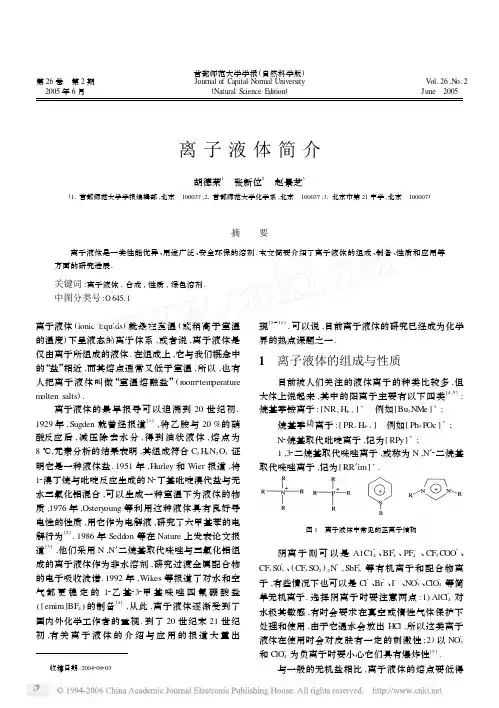
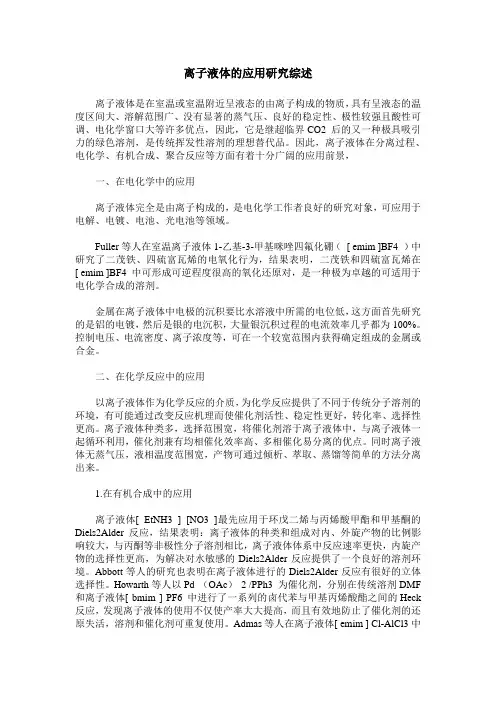
离子液体的应用研究综述离子液体是在室温或室温附近呈液态的由离子构成的物质,具有呈液态的温度区间大、溶解范围广、没有显著的蒸气压、良好的稳定性、极性较强且酸性可调、电化学窗口大等许多优点,因此,它是继超临界CO2 后的又一种极具吸引力的绿色溶剂,是传统挥发性溶剂的理想替代品。
因此,离子液体在分离过程、电化学、有机合成、聚合反应等方面有着十分广阔的应用前景,一、在电化学中的应用离子液体完全是由离子构成的,是电化学工作者良好的研究对象,可应用于电解、电镀、电池、光电池等领域。
Fuller等人在室温离子液体1-乙基-3-甲基咪唑四氟化硼([ emim ]BF4 )中研究了二茂铁、四硫富瓦烯的电氧化行为,结果表明,二茂铁和四硫富瓦烯在[ emim ]BF4 中可形成可逆程度很高的氧化还原对,是一种极为卓越的可适用于电化学合成的溶剂。
金属在离子液体中电极的沉积要比水溶液中所需的电位低,这方面首先研究的是铝的电镀,然后是银的电沉积,大量银沉积过程的电流效率几乎都为100%。
控制电压、电流密度、离子浓度等,可在一个较宽范围内获得确定组成的金属或合金。
二、在化学反应中的应用以离子液体作为化学反应的介质,为化学反应提供了不同于传统分子溶剂的环境,有可能通过改变反应机理而使催化剂活性、稳定性更好,转化率、选择性更高。
离子液体种类多,选择范围宽,将催化剂溶于离子液体中,与离子液体一起循环利用,催化剂兼有均相催化效率高、多相催化易分离的优点。
同时离子液体无蒸气压,液相温度范围宽,产物可通过倾析、萃取、蒸馏等简单的方法分离出来。
1.在有机合成中的应用离子液体[ EtNH3 ] [NO3 ]最先应用于环戊二烯与丙烯酸甲酯和甲基酮的Diels2Alder反应,结果表明:离子液体的种类和组成对内、外旋产物的比例影响较大,与丙酮等非极性分子溶剂相比,离子液体体系中反应速率更快,内旋产物的选择性更高,为解决对水敏感的Diels2Alder反应提供了一个良好的溶剂环境。
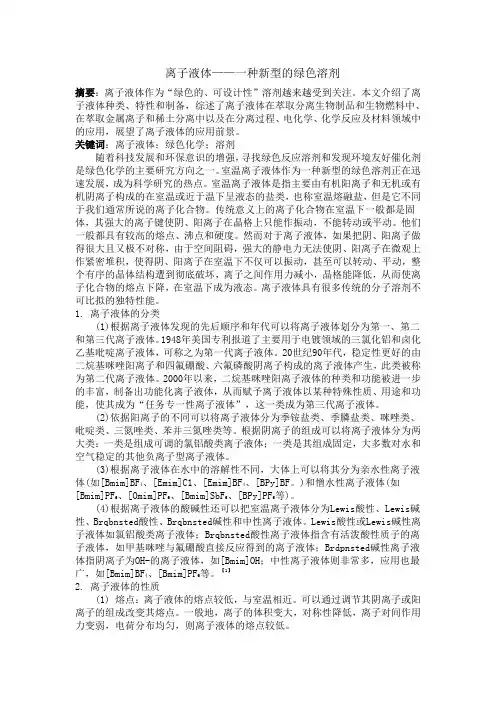
离子液体——一种新型的绿色溶剂摘要:离子液体作为“绿色的、可设计性”溶剂越来越受到关注。
本文介绍了离子液体种类、特性和制备,综述了离子液体在萃取分离生物制品和生物燃料中、在萃取金属离子和稀土分离中以及在分离过程、电化学、化学反应及材料领域中的应用,展望了离子液体的应用前景。
关键词:离子液体;绿色化学;溶剂随着科技发展和环保意识的增强,寻找绿色反应溶剂和发现环境友好催化剂是绿色化学的主要研究方向之一。
室温离子液体作为一种新型的绿色溶剂正在迅速发展,成为科学研究的热点。
室温离子液体是指主要由有机阳离子和无机或有机阴离子构成的在室温或近于温下呈液态的盐类,也称室温熔融盐,但是它不同于我们通常所说的离子化合物。
传统意义上的离子化合物在室温下一般都是固体,其强大的离子键使阴、阳离子在晶格上只能作振动,不能转动或平动。
他们一般都具有较高的熔点、沸点和硬度。
然而对于离子液体,如果把阴、阳离子做得很大且又极不对称,由于空间阻碍,强大的静电力无法使阴、阳离子在微观上作紧密堆积,使得阴、阳离子在室温下不仅可以振动,甚至可以转动、平动,整个有序的晶体结构遭到彻底破坏,离子之间作用力减小,晶格能降低,从而使离子化合物的熔点下降,在室温下成为液态。
离子液体具有很多传统的分子溶剂不可比拟的独特性能。
1. 离子液体的分类(1)根据离子液体发现的先后顺序和年代可以将离子液体划分为第一、第二和第三代离子液体。
1948年美国专利报道了主要用于电镀领域的三氯化铝和卤化乙基吡啶离子液体,可称之为第一代离子液体。
20世纪90年代,稳定性更好的由二烷基咪唑阳离子和四氟硼酸、六氟磷酸阴离子构成的离子液体产生,此类被称为第二代离子液体。
2000年以来,二烷基咪唑阳离子液体的种类和功能被进一步的丰富,制备出功能化离子液体,从而赋予离子液体以某种特殊性质、用途和功能,使其成为“任务专一性离子液体”,这一类成为第三代离子液体。
(2)依据阳离子的不同可以将离子液体分为季铵盐类、季膦盐类、咪唑类、吡啶类、三氮唑类、苯并三氮唑类等。
离子液体概述及其应用 前言:离子液体是仅由阴阳两种离子组成的有机液体,也称之为低温下的熔盐。
离子液体具有低蒸汽压,良好的离子导电导热性,液体状态温度范围广和可设计性等优点。
离子液体所具备的这些其他液体无法比拟的性质,给大部分传统化工反应提供了新的思路,特别是在绿色化学设计中的应用。
本文首先阐述了离子液体的基础知识,而后着重讨论了离子液体在催化及有机合成领域,摩擦领域,生物医药领域中的应用。
主题:一 离子液体概述1.1离子液体的发展及性质20世纪时“离子液体”(IL )仅仅是表示熔融盐或溶盐的一个术语,比如高温盐。
现在,术语IL 大部分广泛的用在表示在液态或接近室温条件下存在的熔盐。
早在1914年,Walden [1]合成出乙基硝酸铵,熔点为12℃,但当时这一发现并未引起关注。
20世纪40年代,Hurley 等人报道了第一个氯铝酸盐离子液体系AlCl3-[EPy]Br 。
此后对这一氯铝酸盐离子液体系进行了不断的扩充,包括各种基团修饰,如N-烷基吡啶,1,3-二烷基咪唑等,另外研究了此类离子液体系在电化学,有机合成以及催化领域的应用并有很好的效果[2]。
但是由于此类离子液体共同的缺点就是遇水反应生成腐蚀性的HCl ,对水和空气敏感,从而限制了他们的应用。
所以直到1992年,Wilkes [3]领导的小组合成了一系列由咪唑阳离子与-4BF ,-6PF 阴离子构成的对水和空气都很稳定的离子液体。
此后在全世界范围内形成了研究离子液体的热潮。
这是由于ILs 存在很多优异而特殊的性质。
(1)液体状态温度范围广,300℃;(2)蒸汽压低,不易挥发;(3)对有机物,无机物都有很好的溶解性,是许多化学反应能够在均相中完成;(4)密度大,与许多溶剂不溶,当用另一溶剂萃取产物时,通过重力作用,可实现溶剂与产物的分离;(5)较大的可调控性;(6)作为电解质具有较大的电化学窗口,良好的导电性,热稳定性。
这些特殊的物理化学性质可以产生许多新应用,同时也会提高现有的科技水平。
离子液体求助编辑离子液体离子液体是指全部由离子组成的液体,如高温下的KCI, KOH呈液体状态,此时它们就是离子液体。
在室温或室温附近温度下呈液态的由离子构成的物质,称为室温离子液体、室温熔融盐、有机离子液体等,目前尚无统一的名称,但倾向于简称离子液体。
在离子化合物中,阴阳离子之间的作用力为库仑力,其大小与阴阳离子的电荷数量及半径有关,离子半径越大,它们之间的作用力越小,这种离子化合物的熔点就越低。
某些离子化合物的编辑本段简介离子液体的历史可以追溯到1914年,当时Walden报道了(EtNH3)+ HNO3-的合成(熔点12℃) 。
这种物质由浓硝酸和乙胺反应制得,但是,由于其在空气中很不稳定而极易发生爆炸,它的发现在当时并没有引起人们的兴趣,这是最早的离子液体。
一般而言,离子化合物熔解成液体需要很高的温度才能克服离子键的束缚,这时的状态叫做“熔盐”。
离子化合物中的离子键随着阳离子半径增大而变弱,熔点也随之下降。
对于绝大多数的物质而言混合物的熔点低于纯物质的熔点。
例如NaCl的熔点为803℃,而50 %LICI-50 %AICl3(摩尔分数)组成的混合体系的熔点只有144℃。
如果再通过进一步增大阳离子或阴离子的体积和结构的不对称性,削弱阴阳离子间的作用力,就可以得到室温条件下的液体离子化合物。
根据这样的原理,1951年F.H.Hurley和T.P. Wiler首次合成了在环境温度下是液体状态的离子液体。
他们选择的阳离子是N-乙基吡啶,合成出的离子液体是溴化正乙基吡啶和氯化铝的混合物(氯化铝和溴化乙基吡啶摩尔比为1:2) 。
但这种离子液体的液体温度范围还是相对比较狭窄的,而且,氯化铝离子液体遇水会放出氯化氢,对皮肤有刺激作用。
直到1976年,美国Colorado州立大学的Robert利用AICl3/[N-EtPy]Cl作电解液,进行有机电化学研究时,发现这种室温离子液体是很好的电解液,能和有机物混溶,不含质子,电化学窗口较宽。
有机合成中的离子液体催化研究综述近年来,离子液体作为一种新型的催化剂在有机合成领域引起了广泛的关注。
离子液体具有独特的物化性质,可以调控反应的速率和选择性,从而在有机合成中发挥重要作用。
本文将综述离子液体在有机合成中的应用及其催化机理。
第一部分:离子液体的基本特性离子液体是一类具有低熔点的有机盐,其熔点通常低于100℃。
离子液体由阳离子和阴离子组成,可以根据需要设计合成不同的离子对。
离子液体具有良好的溶解性、热稳定性和可重复使用性,可以作为绿色催化剂替代传统的有机溶剂。
第二部分:离子液体在有机合成中的应用离子液体可以在有机合成中发挥多种催化作用,包括酸催化、碱催化、金属催化和离子催化等。
其中,离子液体作为酸催化剂可以催化酯化、醚化、醇缩合等反应;离子液体作为碱催化剂可以催化酯水解、烯烃加氢等反应;离子液体作为金属催化剂可以催化氧化还原反应、氢化反应等;离子液体作为离子催化剂可以催化烯烃聚合、烷基化等反应。
这些反应中,离子液体催化剂可以提高反应的速率和选择性,同时减少副产物的生成,具有重要的应用价值。
第三部分:离子液体催化机理的研究进展离子液体催化机理的研究对于揭示催化反应的本质和提高催化效率具有重要意义。
目前,研究者通过理论计算、实验表征和反应动力学等方法,对离子液体催化反应的机理进行了深入研究。
研究结果表明,离子液体催化剂通过形成氢键、离子对相互作用和空间位阻效应等方式,调控反应的活性中心和过渡态结构,从而影响反应的速率和选择性。
第四部分:离子液体催化的应用案例离子液体催化在有机合成中已经取得了一系列的重要应用。
以酯化反应为例,研究者利用离子液体作为酸催化剂,可以在较低的温度下实现高转化率和选择性。
另外,离子液体催化剂还可以用于有机合成中的催化转化、催化剂的回收和废水处理等方面,具有广阔的应用前景。
结论:离子液体作为一种新型的催化剂,在有机合成中具有广泛的应用前景。
离子液体催化剂可以调控反应的速率和选择性,提高催化反应的效率和环境友好性。
绿色化学中的离子液体摘要本文评述了离子液体的一般性质及其在一系列化学反应中的应用,并且展望了它作为绿色溶剂的将来。
关键词绿色化学绿色溶剂离子液体迄今,绝大多数化学反应都在分子溶剂中进行,如水和多数常见的有机溶剂。
近年来一种新的溶剂-离子液体的出现引起了各国学者的关注。
该溶剂在室温下是流质(也称为室温离子液),而组成是离子系列的,组成该溶剂至少有两种成份,即可变换的阳离子和阴离子。
由于该溶剂可按利用者的需要或具某些特种性质而设计,所以又称之为“设计者溶剂”。
离子液体既可作溶剂又可作催化剂,在该液体中进行反应的热力学和动力学与在普通溶剂中有所不同的,一般说来,离子液体对热稳定,不可燃,不挥发,不氧化,不爆炸,低毒性,故用于合成反应中是清洁友好的。
已有的报导证明,离子液体增加了反应的活性、选择性及催化剂的稳定性等,更深地探索会发现一些新的不可预见的事物,激发人们聚焦于此的原因还在于人们一直倡导绿色化学和绿色合成。
离子液体的领域已有综述,它包括Welton [1],Wasserscheid 和Keim[2],以及Freemantle[3],特别是长期从事这一领域研究的Seddon等[4]。
第一个常温离子液体[EtNH3][NO3](mp. 12 ℃)于1914年发现,但仅在上世纪七十年后才有新的进展[5、6]。
离子液体包括两大类:一类是简单的盐,由有机阳离子和阴离子组成,有机阳离子通常包括有季铵阳离子、季膦盐阳离子、杂环芳香化合物及天然产物的衍生物等,其中常见的是咪唑盐,如另一类是二元离子液体(即含有平衡的盐)。
例,AlCl3(Ⅲ)和氯化1-甲基-3-乙基咪唑盐的混合物,它含有几种不同的离子系列,它们的熔点和性质取决于组成,常用[C2mim]Cl-AlCl3来表示这个络合物。
离子溶液被称为“设计者溶剂”,那么它的熔点,粘度,密度和疏水等性能可用简单地变换离子结构来控制。
如[Rmim]BF4的烷基链长(C数)小于6时,在25 C时与水混溶,当链长大于6时,它就与水不混溶了,这种行为对反应的选择和产物萃取和分离有利。